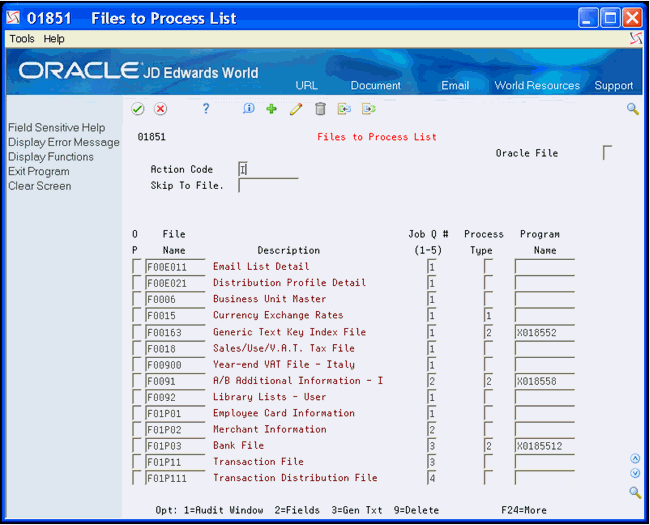B Address Book Consolidation
You might have the need to consolidate or merge two different address book records into one address book record. For example, if one of your customers works with two different data entry personnel, both of whom receive an order from this customer and both enter that customer into the Address Book system separately. After a few months, you run reports that show that address book record 1001 and address book record 1002 are the same customer. You prefer to maintain all data for this customer (invoices, address book records, sales orders, etc.) using one address book number. You can now consolidate the two address book records into the 1001 address book record number.
Caution:
If you perform a consolidation without proper preparation, it can result in serious data integrity issues. This process eliminates one Address Book Number in over 400 files and replaces it with the Address Book Number you specify.After you perform the consolidation, JD Edwards World recommends that you review the data. When you are certain that the consolidation is error free, you must then rebuild workfiles, such as As Of files. You must also recalculate Address Book statistics, such as Invoice Year to Date and Voucher Year to Date. You can verify the financial account balances by running the Repost Account Ledger program (P099105) in proof mode. If you no longer require the consolidation control records and statistics, you can purge the consolidation data from your system. The system maintains the key consolidation record for future reference.
Note:
The system prohibits you from using employees, ex-employees, applicants and dependents/beneficiaries as Search Types in this process. You can protect additional Search Types, particular to your organization, by adding them to the UDC 01/NC.You can use the A/B - Check For Duplicates (J014052) or Address Book - w/ Tax ID and Person/Corp Code (J014032) programs on the Address Book Consolidation Preparations menu (G003141) to assist you in identifying duplicate address book numbers that you might want to consolidate. JD Edwards World recommends that you run these programs occasionally and evaluate the state of your Address Book files.
You can also run the three DREAM Writer transaction reports using certain large transaction files and view which records will change if you run the consolidation for a specific Address Book Number. These include DEMO versions with the Data Selection set correctly for this task and you must enter the Address Book Number you want to research.
If you need to restore purged data, you should contact Customer Support to discuss options for consolidating restored data.
Consolidating records includes these tasks, contained in this appendix:
-
Appendix B, "Setting Up Address Book Files for Consolidation,"
-
Appendix B, "Setting Up Address Book Numbers for Consolidation,"
-
Back up all data files.
-
Complete all processes where the From and To Address Book Number exists in a workfile such as A/P Payments, Positive Pay, Budget Upload and EDI as the system does not update workfiles with the To Address Number.
-
Ensure you clear the Consolidation Code field using the Address Book Control Revisions (P010513) or Consolidation Code Revisions (P01016) programs for the From Address Book Number if you group address book numbers.
-
Run the GenTxtCnv *BUDGET* Keys - F00164 program (J00164H03) on the Address Book Consolidation Preparations menu (G003141) only once to correct some existing Generic Text Keys which are necessary for the consolidation. The system correctly saves all text you add at a later time.
-
You do not need to run the Address Book Consolidation - File Merge program (P01859) program if you are installing A9.2 Base, whether this is an upgrade to A9.2 or via a PCCPY. If you are upgrading to a new release and Address Book Consolidation exists on your system, then you must run this program after applying the upgrade, before you perform an address book consolidation.
-
Set up custom files if you are an ECS customer that uses commingled stock. See Appendix B, "Setting Up Custom Files for Commingled Stock."
B.1 Merging Files to Process
The Address Book Consolidation - File Merge program (P01859) merges your existing Address Book Consolidation - Processing File List - Header (F01851) and Address Book Cons - Processing File Fields List - Detail (F018511) files in your current user library with the F01851 and F018511 files in the JD Edwards World Data library (JDFDATA) you receive with each new release of Address Book Consolidation.
You must run this program because JD Edwards World can add or delete files and fields to the list of files and fields that are included in the consolidation. As you can customize your system by adding Client Reserved files, assigning job queues to JD Edwards World files, and adding User Reserved Number (URAB) fields to JD Edwards World files, JD Edwards World cannot replace the F01851 and F018511 file in each new release. Therefore, JD Edwards World must merge the two sets of file information in order to maintain your system-specific information. JD Edwards World preserves the job queues you assign to all files, all custom files that exist on your system, and the addition of the URAB fields in any files.
You can run this program in proof or final mode. This program generates a report, whether you run it in proof or final mode, listing any files that are in your F01851 that you did not code to a custom system code and are not in the JD Edwards World JDFDATA library with a new release. When you run the merge in proof mode, the program does not perform updates. When you run the merge in final mode, the program updates and replaces the data in the F01851 and F018511 files. The program deletes the non-custom system code files during the merge, so you must perform one of the following:
-
Change the Product Code in SVR to 55-59 for these files, designating them as custom files
-
Allow this program to delete them and you can manually enter them after the merge
From Address Book Consolidation Preparations (G003141), choose File and Field File Merge
B.2 Setting Up Address Book Files for Consolidation
The Address Book Consolidation - Files to Be Processed program (P01851) displays a list of all files on the Files to Process screen that you want to process for Address Book Consolidation. Each file that contains at least one Address Book field must display on this list so that the consolidation process can make the necessary changes to the file. All the Address Book fields are from the Address Book Cons - Processing File Fields List - Detail file (F018511) and you can access these from the Files to Process screen. The consolidation process tracks the consolidation of each From/To pair in each of the files that display in this program.
In order for the consolidation to convert the data properly in the file, you must specify what type of processing the system performs for each file. JD Edwards World recommends that you do not revise the processing type for the JD Edwards files in the list. You can choose any of the following processing types for the custom files you create:
-
Standard Processing via program X01855.This converts any of the designated fields in the From address to the To address.
-
Standard Processing via program X01855.This causes the consolidation program to delete any record that includes the From address in the field designated.
-
Special Logic via the program number you enter in the Program Name field. These program numbers are X01855x where x is a sequence number. You use this type of processing due to potential duplicate key issues or the need to evaluate information found outside the file itself.
Both Z-Files and EDI files are in the Files to Be Processed list. This allows you to run a consolidation prior to processing these files. If you purge these files regularly or do not rely on them for information in the future, you might want to remove these files from the list to increase processing time.
To increase the efficiency of the consolidation, all processes run in batch mode. You can specify which Job Queue you want to use for each particular file. You should allocate the larger jobs to different job queues so they can process simultaneously versus sequentially.
Address Book Consolidation includes all JD Edwards World files and fields that contain address book data for you to consolidate. It is not necessary to change any of the files that display on the screen; therefore, you should leave the processing option blank to change to only the job queue. If you feel it is necessary to change any of the JD Edwards World files and fields enter 1 in the processing option and contact your System Administrator prior to consolidation. You can add any Client Reserved files and fields (System 55-59) that you might also want to consolidate. In addition, you can include the URAB field in a specific file in which you choose the Standard Processing Type.
Note:
JD Edwards does not include the main Address Book files that contain all information related to the Address Book Number in the consolidation. This includes, but is not limited to the Address Book Master (F0101), Customer Master (F0301), Supplier Master (F0401), and Bank Transit Number Master File (F0030) files. JD Edwards preserves the From Address Book information. After you verify that you no longer need this information, you run the Address Book Purge with Who's Who, Memos (P01800) to delete this Address Book Number from your files and free it up for future use.To set up address book files for consolidation
From Address Book Consolidation (G00314), choose Files to Process List
-
On Files to Process List, locate the files to process on your system.
-
To narrow your search, complete the following optional field:
-
Oracle File
-
-
To access the fields for a file, enter 2 in the Option field.
Figure B-2 Files to Process List (Option) screen

Description of "Figure B-2 Files to Process List (Option) screen"
-
On AB Consolidation - File Fields to Process, you can enter 9 in the Option field next to the fields you want to delete and click Enter.
-
On Files to Process List, complete the Process Type field.
-
Complete the following optional field:
-
Program Name
-
-
Click Change.
-
To add generic text to a file, enter 3 in the Option field.
Figure B-3 Address Book Consolidation - File Fields to Process screen.
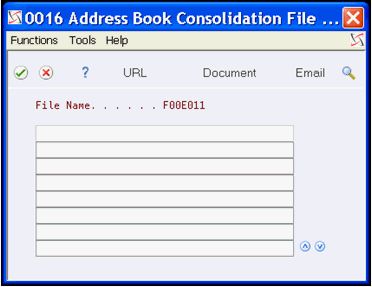
Description of "Figure B-3 Address Book Consolidation - File Fields to Process screen."
-
On Address Book Consolidation File, enter the text and click Enter.
-
On Files to Process List, you can enter 9 in the Option field next to the files you want to delete and click Enter.
| Field | Explanation |
|---|---|
| Process Type | Each file processed in Address Book Consolidations will fall within one of these three processing methods:
Blank = Standard processing. The consolidation process will count all records to be changed from one Address Number to another, the records will be changed and if you are reporting or saving the keys to these records, each record will be written to the archive file. 1 = Deletion. The consolidation program will simply delete all records for the From Address Book Number. These are secondary files with information no longer needed for the From Address as the To Address information should already be in this file or should be manually added. '2' = Program Call. The consolidation program can't process these files with the standard SQL statements or deletion process. Specific Code for these files is necessary and requires a call to a different processing program. Screen-specific information If you leave this field blank, the program changes all occurrences of the From Address to the To Address for each field within each file that displays. |
B.3 Setting Up Custom Files for Commingled Stock
ECS customers that use commingled stock must perform changes to the Address Book Consolidation - Files to Be Processed program (P01851) to set up four files as custom files. You must perform these changes each time you download a new release or a cumulative update of JD Edwards World software because this resets the Files to Be Processed to JD Edwards World standards and these four files are not coded as custom.
To set up custom files for commingled stock
From Address Book Consolidation (G00314), choose Files to Process List
-
On Files to Process List, enter F41021 in the File Name field.
-
Enter 2 in the Process Type field.
-
Enter X018557 in the Program Name field and click Add.
-
Locate each of the following files, perform the preceding steps for each file and then click Change.
-
Item Ledger File (F4111)
-
Sales Order Detail File (F4211)
-
Gantry Interface Actuals File (F49572)
-
-
Exit (F3).
B.4 Setting Up Address Book Numbers for Consolidation
Use the Address Book Consolidation Workbench program (P01850) to set up which Address Book Numbers you want to consolidate into other Address Book Numbers, run, and monitor all consolidations. To set up address book numbers for consolidation, you enter the From and the To Address Book Numbers in the detail portion of this screen, with the following restrictions:
-
You cannot enter any Payroll Search Types. These are hard coded in UDC 01/NC. You can also prohibit other Search Types as well by entering them in UDC 01/NC.
-
You cannot consolidate From or To a One Time Payment Supplier.
-
You must have authority for both Business Unit and Search Type for the program to process both the From and the To Address.
-
The From Address:
-
Must be Inactive
-
Cannot be a company (CCCO or CCAN8 in Company Constants file (F0010)).
-
Cannot be a parent in the Organizational Structure.
-
Cannot have active PPAT messages or Bulletin Board entries from the PPAT Message Distribution (F01133) and Bulletin Board Enrollment (F01134) files.
-
To set up address book numbers for consolidation
From Address Book Consolidation (G00314), choose From/To Address Workbench
-
On From/To Address Workbench, complete the following fields in the detail area and click Add:
-
From Address
-
To Address
Figure B-4 From/To Address Workbench screen
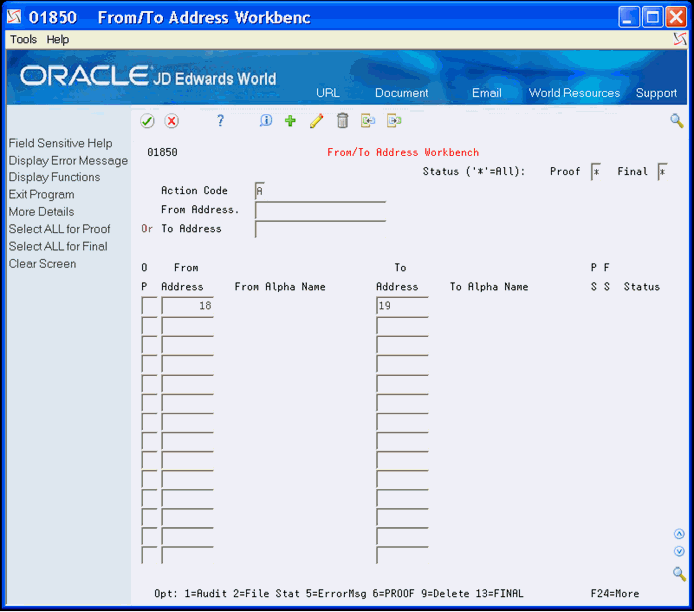
Description of "Figure B-4 From/To Address Workbench screen"
-
B.5 Consolidating Address Book Numbers
After you set up which Address Book Numbers you want to consolidate into other Address Book Numbers you run and monitor all consolidations.
You can consolidate Address Book Numbers using either of the following methods:
-
Interactively, by accessing the Address Book Consolidation - Processing Program (P01855) from the Address Book Consolidation Workbench program (P01850).
-
By Batch, using the Address Book Consolidation - Processing Program (P01855).
Whichever method you choose, the following apply to both methods:
-
You can only run the consolidation in proof mode if the Final field value is blank, 2 or X and the Proof field value is not 1. You can only run the consolidation in final Mode if the Proof field value is 3 or the Final field value is 2.
-
You can run the consolidation in proof or final mode.
-
The program produces the Address Book Consolidation - Processing Error Report (R01855E) that lists any From/To pair, file authorization, or missing field errors. The system detects the errors, in proof or final mode, before it processes any files for consolidation.
-
After you review the records, are certain the consolidation completes in final mode, is error free, and meets your requirements, you must:
-
Run programs to repost
-
Recalculate accumulated amounts (invoice and voucher year to date)
-
Rebuild As Of files for the To address
-
Purge consolidation data
-
Using the interactive method, you access the Address Book Consolidation Workbench program (P01850) and the following functions are available:
-
Access to the Audit Window
-
Enter Generic Text
-
Run a Proof Consolidation (for one or a group of From/To pairs)
-
Run a Final Consolidation (for one or a group of From/To pairs)
-
Access the Files in Progress program to monitor all of the files
-
Access the errors the program encounters during proof or final consolidation
-
Select All for Proof Consolidation (F6)
-
Select All for Final Consolidation (F13)
Using the batch method, you use a DREAM Writer version of the Address Book Consolidation - Processing Program (P01855) to consolidate Address Book Numbers in a batch. After you launch this program, use the Address Book Consolidation Workbench program (P01850) to monitor all consolidations and access data.
B.5.1 Monitoring Progress
After you launch the consolidation, you monitor the progress of all consolidations from the Address Book Consolidation Workbench program (P01850). The consolidation occurs in a series of steps and the consolidation of one From/To pair can take a considerable amount of time. In order to track the progress and result of a consolidation, you can review the proof and final status fields for both the pair and each file in which the pair exists. In the detail area of the workbench, the status of the consolidation displays in the Proof and Final fields.
The Address Book Consolidation - Processing Program (P01855) also validates the files and fields. If an error occurs during validation of the files, fields, or the status of the From or To address, the program creates an error report for the file error and terminates the consolidation without changing any files.
To prevent file and field errors, you must:
-
Possess authorization to all of the files.
-
Specify at least one field for each file in the consolidation.
As the P01855 consolidates and updates the files, it saves the relative record number of any records with an update error and sets the status to 2 (error). The errors display in the Address Book Consolidation - Error Messages program (P01853). Some errors the special processing programs issue are specific. The most common errors you encounter are due to either a record lock or corrupt data that causes the update to that file to end abnormally. JD Edwards World recommends that you use the relative record number to locate the record in error, evaluate and correct the record, and then run the consolidation. The consolidation processes any files that do not contain a status of 3 (complete).
B.5.2 Accessing Data
After you run the consolidation, you can also access all data that relates to the consolidation, such as the files in process, consolidation errors, and files in process audit records. You use the fields in the header to locate all consolidations that you set up as well as those that you have processed previously.
You can access the Address Book Consolidation - Files in Process Status program (P01852), to review a list of the files you are consolidating, including the status for each file throughout the consolidation. On the AB Cons - Files in Process screen, the Proof and Final Status field values for the files are the same as the From/To pairs. The number of records in the file that the program expects to change or delete displays when you run the consolidation in Proof mode. When you run the consolidation in Final mode, the number of records the program did not update, due to errors also displays on this screen. This count, along with the Final status, indicate if the program encounters errors, such as record locks or duplicate record keys that prevent the program from changing or deleting a record. When the program runs in Final mode successfully, this count is zero.
From the AB Consolidation - Files in Process screen you can access the Address Book Consolidation - Error Messages program (P01853) to review the relative record numbers of the records that the program did not update. You might need to reevaluate the record and make corrections or, in the case of record locks, you run the consolidation program again in Final mode to consolidate those records.
Each time the status of the file changes for the Files in Process, the program saves a record in the Address Book Cons - In Process From To/Files - Audit File file (F01852A). This enables you to track the progress of each file update and the overall progress of the consolidation.
Complete either of the following tasks:
-
To consolidate address book numbers interactively
-
To consolidate address book numbers by batch
To consolidate address book numbers interactively
-
On From/To Address Workbench, complete one of the following fields in the header and click Inquire:
-
From Address
-
To Address
-
-
To narrow your search, complete the following optional fields:
-
Proof
-
Final
Figure B-5 From/To Address Workbench (Consolidate) screen
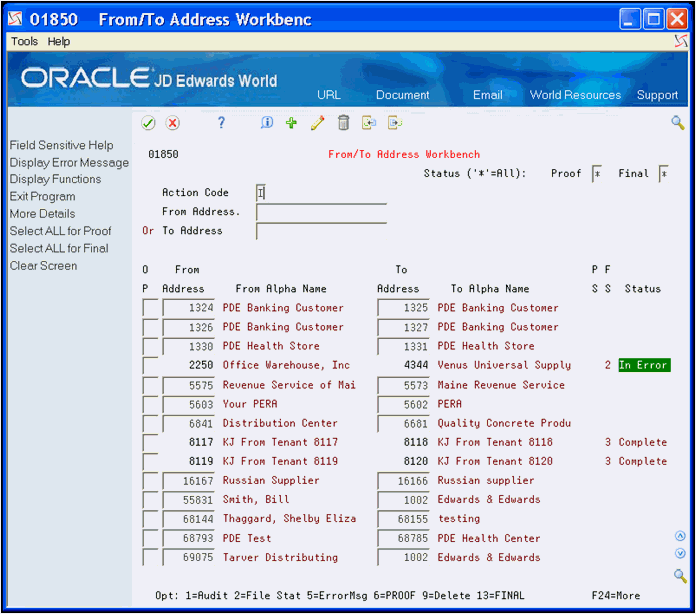
Description of "Figure B-5 From/To Address Workbench (Consolidate) screen"
-
-
Perform one of the following and click Enter.
-
Enter either 6 (Proof) or 13 (Final) in the Option field for the consolidation you want to run.
-
Choose Select ALL for Proof (F6) or Select ALL for Final (F13).
When the consolidation completes the status displays in the Status field.
-
-
On From/To Address Workbench, enter 2 in the Option field to view the status of the files in process for the consolidation.
Figure B-6 Address Book Consolidation - Files in Process screen
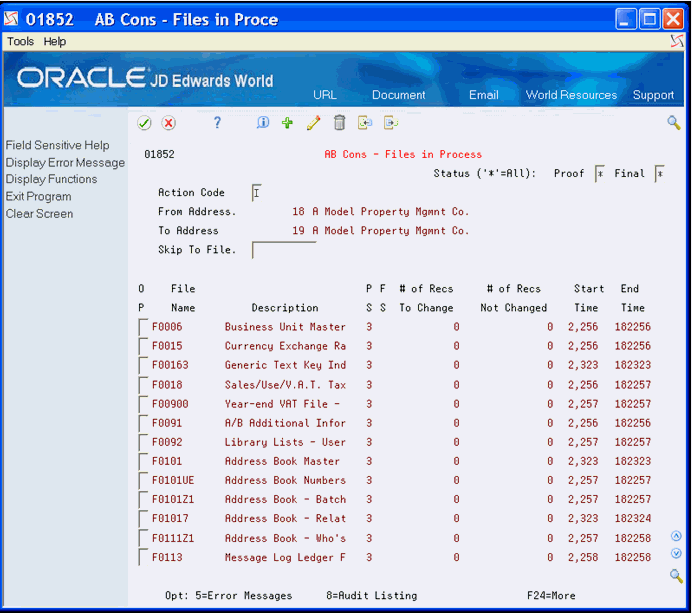
Description of "Figure B-6 Address Book Consolidation - Files in Process screen"
-
On AB Consolidation - Files in Process, enter 5 in the Option field to view the errors in the file for the consolidation.
-
Click Exit (F3).
-
On AB Consolidation - Files in Process, enter 8 in the Option field to view the audit information for the file for the consolidation.
Figure B-7 Address Book Consolidation - Files in Process/Audit screen

Description of "Figure B-7 Address Book Consolidation - Files in Process/Audit screen"
-
Continue to click Exit (F3) to access From/To Address Workbench.
-
On From/To Address Workbench, enter 5 in the Option field to view the errors in the file for the consolidation.
Figure B-8 Address Book Consolidation - Error Message screen
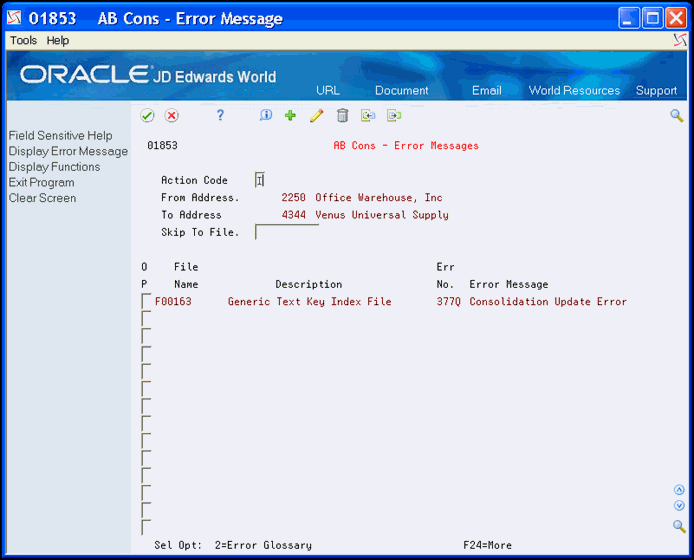
Description of "Figure B-8 Address Book Consolidation - Error Message screen"
-
Click Exit (F3).
| Field | Explanation |
|---|---|
| P (Proof) | This status is used to track movement within a process.
For Address Book Consolidation, this data item will be used to track the status of each From/To Address Book pair as well as each of the files being processed for that pair in Proof Mode. The allowed values are as follows: blank = Unprocessed '1' = In progress '2' = Halted due to Error '3' = Completed successfully |
| F (Final) | This status is used to track movement within a process.
For Address Book Consolidation, this data item will be used to track the status of each From/To Address Book pair as well as each of the files being processed for that pair in Final Mode. The allowed values are as follows: blank = Unprocessed '1' = In progress '2' = Halted due to Error '3' = Completed successfully 'X' = Final ended in Error. Currently in Proof Mode. |
To consolidate address book numbers by batch
From Address Book Consolidation Preparations (G00314), choose Run Consolidation in Batch
B.6 Purging Address Book Records
Caution:
Use extreme caution when using this purge program.After you review the records, you can purge the From Address Book data to free that Address Book Number for future use. Prior to purging data, ensure the consolidation:
-
Completes in final mode
-
Meets your business requirements
Prior to purging data, ensure you:
-
Run programs to repost
-
Recalculate accumulated amounts (invoice and voucher year to date)
-
Rebuild As Of files for the To address
See Section 42.1, "Purging Address Book Information and Related Files" for more information about purging Address Book data.
Back up your current Address Book files and any other files that the program purges before executing this purge.
From Address Book Consolidation Preparations (G00314), choose Address Book Purge
B.7 Purging Consolidation Files
Periodically, you should remove all of the information for previously completed consolidations. Use the Address Book Consolidation Purge program (P018001) to remove all From/To pair information from all of the Address Book Consolidation files.
Only those From/To pairs with a value of 3 (completed successfully) in the Final Status field and without errors are eligible for purge. If you did not run the consolidation program in Final mode on a pair, you can delete the record from the Address Book Consolidation Workbench program (P01850).
You can run the purge program in proof or final mode. The program generates the Address Book Consolidation Purge report whether you run the program in proof or final mode. JD Edwards World recommends that you run this program in proof mode first. Use the Print Report Information processing option to obtain a list of all From/To pairs that are either eligible or ineligible for purge. Run this program in final mode to purge the addresses you choose. Use the Print Report Information processing option to obtain a list of all From/To pairs that the program purges.
The P018001 performs the following when you run it in Final mode:
-
Saves the From/To pair record in the Address Book Consolidation - From/To Addresses file (F01850) in the Address Book Cons - From/To Addresses - Purge File (F01850P) file for future reference of this consolidation record.
-
Clears the following files of this From/To pair:
-
Address Book Consolidation - In Process From To/Files (F01852)
-
Addr Book Cons - In Process From To/Files - Audit File (F01852A)
-
Address Book Consolidation - Files/Keys Updated (F01853)
-
-
Deletes the Generic Text *ABCONS for the From/To pair.
From Address Book Consolidation Preparations (G00314), choose Consolidation Purge
